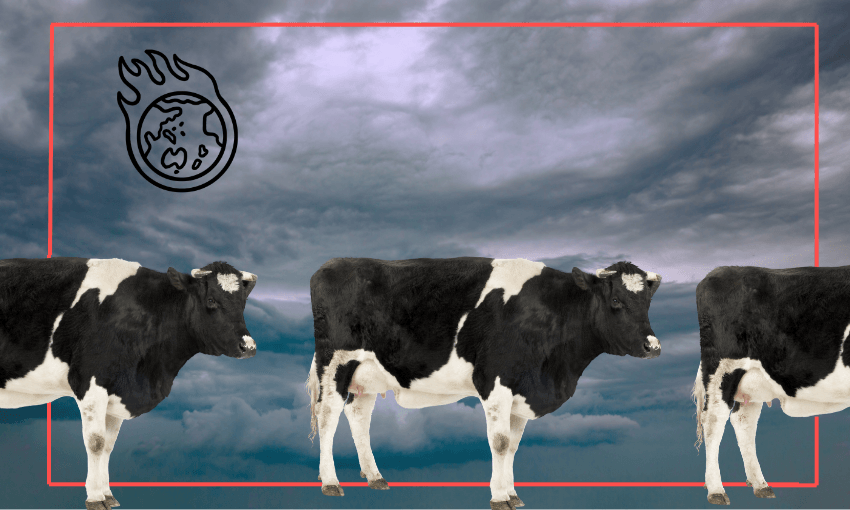A group of scientists from around the world is urging the New Zealand government to ignore a methane report it commissioned that ‘redefines the goal of climate action’. Shanti Mathias explains.
I hear there’s an open letter. What’s that about?
Twenty-six climate scientists have signed an open letter urging the government not to adopt a standard that would limit the amount of methane reduction New Zealand needs to achieve to reach its climate target.
A review of New Zealand’s methane targets, conducted in 2024 by a government-appointed group separate from the independent Climate Change Commission, looked at the goal of “no additional warming”. The open letter says that “no additional warming” is a goal that “ignores scientific evidence” and could jeopardise New Zealand’s ability to achieve the goals set out in the Paris Agreement.
What does ‘no additional warming’ mean?
This term is a way to avoid responsibility, says the open letter. “It redefines the goal of climate action as simply stabilising the warming impact of emissions from any given source at current levels – rather than seeking to ‘minimise all greenhouse gas emissions’ and their contribution to global warming.”
The concept of “no additional warming” is supported by agricultural lobby groups like Beef and Lamb and Federated Farmers. It would mean that methane emissions could be kept at current levels, as long as they don’t increase; essentially an endorsement of the current amount of climate change. “It’s kind of like saying ‘I’m pouring 100 barrels of pollution into this river and it’s killing life. If I go and pour 90 barrels of pollution in, I should get credit for it,” Paul Behrens, a professor at Oxford University and signatory of the letter, told the Financial Times.
Farming lobby groups are pushing for the government of Ireland to adopt a similar approach, which scientists have also criticised.
Why are New Zealand and Ireland being singled out?
Both countries have large agriculture sectors which produce a lot of dairy and beef for export, and have very high per-capita methane emissions. The vast majority of methane emissions come from agriculture; more than 85% in New Zealand, from grass-eating animals like cows and sheep burping it out as they digest their food. Methane made up 28.9% of Ireland’s emissions in 2022 and 43.5% of New Zealand’s emissions in 2020. By comparison, methane is about 12% of the United States’ emissions.
Drew Shindel, an American professor who chaired the UN Environmental Programmes 2021 global methane assessment, told RNZ that the “no additional warming” target set a “dangerous precedent”. If New Zealand and Ireland adopted this standard and were followed by other countries, methane emissions wouldn’t be reduced fast enough to meet Paris Agreement targets that are already in jeopardy.
Methane is a particularly dangerous source of emissions. While it stays in the atmosphere for less time than carbon dioxide, it causes 80 times as much heating, and causes that heating almost immediately – meaning that if methane continues to be emitted, its dangerous warming effects will continue, too. As a recognition of its more short-lived nature, the amount of methane New Zealand needs to reduce by 2050 is a separate goal to carbon emissions reductions. By 2050, New Zealand is aiming to have net-zero carbon dioxide emissions and a 24% to 47% reduction of methane. By 2030, New Zealand is aiming to have a 10% reduction of methane from 2017 levels.
How have New Zealand politicians reacted to this call to reduce methane?
Fairly predictably. Christopher Luxon, to whom the letter was addressed, said that the scientists, whom he described as “worthies”, “might want to direct their focus and their letters to other countries”. He told RNZ “I’ll stack New Zealand’s record up against any other country on the planet Earth around our methane emissions,” saying that if New Zealand limited dairy or beef production, those emissions would be produced elsewhere by countries with less environmental efficiency.
Chlӧe Swarbrick, co-leader of the Green Party, said that the “no additional warming” measure could damage New Zealand’s reputation and threaten its exports. “It’s really clear that Christopher Luxon has to end any further speculation that his government is on the climate denial bandwagon, they have wasted a year playing around with this mythical notion of ‘no additional warming’ and now international alarm bells are ringing,” she said.
Following the report of the methane panel last year, Cabinet will decide whether to adopt a different methane target.
Is New Zealand on track to meet its climate targets otherwise?
No. Current policies rely on tree planting and a carbon capture and storage project in the Kapuni gas field, which currently seems completely unviable. The second emissions reduction plan, released last year, put the net zero 2050 target out of reach with domestic targets, meaning New Zealand will likely have to buy millions of dollars of international carbon credits. The organisation Climate Action Tracker rates New Zealand’s progress as “highly insufficient” with current policies headed towards heating of more than four degrees Celsius. Changes to climate finance in the recent budget also mean that New Zealand is not doing its part to support less well-off countries adapt to a warmer planet and reduce their emissions.




